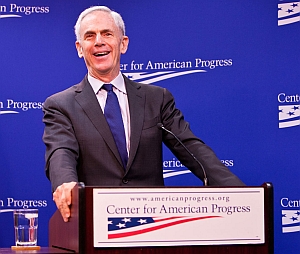The U.S. Department of Commerce released today a report to Congress on “The Competitiveness and Innovative Capacity of the United States” called for by the America COMPETES Reauthorization Act of 2010. Secretary of Commerce John Bryson (pictured left) discussed the report’s main findings in a briefing at the progressive think tank Center for American Progress in Washington, D.C.
The report covers a range of topics related to competitiveness and innovation, but focuses on three main variables — basic research, education, and infrastructure — highlighting potential contributions of government in these factors. “Government may not have all the answers,” said Bryson, “but it has a role to play.”
Investments in these areas lead to more competitive economy and higher growth, said Bryson. But investments in these areas have not kept pace with economic growth, and as a result economic performance has slipped in the past decade.
The report recommends federal funding be increased for basic research conducted institutions such as universities and national labs. Bryson noted that in 1980, the federal government funded 70 percent of basic research in the U.S., but the government’s share has now dropped to 57 percent. “That trend must be reversed,” said Bryson.
While government may have the lead in basic research, both the report and Bryson noted that the private sector also makes a significant contribution. The report calls for an extension of the research and development tax credit that provides an incentive for companies to invest in R&D.
American universities may offer higher education to a broad segment of the population, but education in science, technology, engineering and mathematics, or the STEM fields, came in for special attention in the report. To succeed in the global economy, notes the report, government must encourage students and workers to pursue STEM education. Bryson noted that only 12.8 percent of American university students pursue STEM studies, compared to 44 percent of international students in the U.S. “That must change,” said Bryson.
The report also pointed out the benefits to women who pursue STEM education. Women with STEM jobs, for example, earned 33 percent more than comparable women in non-STEM jobs. As a result, the gender wage gap is smaller in STEM jobs than in non-STEM jobs.
The report’s discussion of infrastructure investments focuses on upgrades needed in the U.S. electrical grid and broadband and wireless networks that are needed to support 21st century technologies and economic opportunities derived from those technologies. Bryson noted that broadband Internet access now reaches two-thirds (68%) of American households, “but one-third of the households are still cut out.” He added that broadband needs to reach “citizens and businesses no matter where they are,” including more remote rural regions.
Both the report and Bryson pointed out the economic benefits to companies, particularly small companies, that get Internet access. Small- and medium-sized companies created more than twice the number of jobs as firms not on the Internet, creating 2.6 jobs for each one eliminated.
The report includes a discussion of the special role played by manufacturing in stimulating innovation. Manufacturing in the U.S. continues to pay higher than average wages and provides the bulk of U.S. exports. Two-thirds of all R&D by businesses in the U.S. is done by manufacturers, even though they represent only 11 percent of GDP and nine percent of employment. That employment represents 11 million workers in the U.S., but as important, manufacturing is also a key driver of economic and job growth, and as Bryson noted, “sustaining a strong middle class.”
The report recommends continuing current initiatives related to manufacturing such as revitalization of the automobile industry, White House Office of Manufacturing Policy, Advanced Manufacturing Partnership, Materials Genome Initiative, and National Digital Engineering and Manufacturing Consortium.
Read more: White House Unveils Manufacturing Partnership, Investments
* * *


 RSS - Posts
RSS - Posts
[…] Report Outlines U.S. Competitive, Innovation Roadmap […]